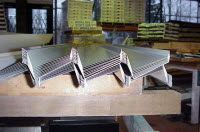Being the last line of defense against water leakage, proper roof flashing is an important part of the metal roof installation process. Flashing typically forms the joints, or intersections, and terminations of various metal roofing systems and surfaces, including roof-to-wall intersections, ridges, skylights, rakes, eaves, roof penetrations, chimneys, and valleys – where it directs rain water or snow down and off the roof.
Metal roof flashing must be configured to counter the three factors that cause water penetration: gravity, water surface tension, and wind pressure. This is usually achieved through the use of lapped-shingle design style, soldering or sealing to achieve a continuous surface. The flashing may also be designed using a non-continuous profile to resist surface tension.
When choosing flashing materials for corrugated or any other type of metal roof, it’s important to consider their durability, maintenance requirements, weather resistance, and ability to accommodate movement. Of course, such materials should also be compatible with metal or other adjacent roofing products.
The flashing materials that work best with metal roof installations include:
Aluminum
Aluminum flashing is one of the most popular options for metal roof systems. This is because it’s versatile, durable, and can be used for a wide variety of roof flashing applications including valley flashing, chimney flashing, base flashing, step flashing, and counter flashing.
Aluminum roof flashing comes in sheets, rolls, and pre-fabricated shapes for specific projects such as flashing for drip edges. It is also available in varying thickness, with the thicker options being more resistant to elements.
Aluminum flashing is available in both standard (mill) finish and factory paint finishes such as white and bronze.
Mill- or paint-finished aluminum flushing works amazingly well with field-applied paint, allowing you flexibility when it comes to selecting your desired finish.
The main problem that is associated with aluminum flushing is that it cannot be field soldered. This makes it hard to make water-tight seams. To create a barrier that is impossible for water to penetrate, you must lap joints and fasten them mechanically. You may also have to undertake additional caulking using a high performance sealant to prevent leakage.
Remember, it’s important that you use compatible aluminum nails to avoid galvanic action, which occurs between dissimilar materials like aluminum and steel nails leading to deterioration.
Pros
- Although it does not come cheap, aluminum is affordable as it’s in the mid-cost range of flashing materials.
- Aluminum is a soft and workable material, allowing you create different forms that hold their shape well to meet your specific needs.
- Pre-fabricated aluminum drip edges make for quick and effective installation.
Cons
- When left uncoated, aluminum flashings are susceptible to different elements such as acid rain, excessive heat, salt air, heavy snows and strong, scouring winds.
- Aluminum cannot be installed on metal roofing, where they may come in direct with mortar, concrete, fiber-cement sidings and trims, as the alkalinity in such materials can cause corrosion.
- Making watertight joints and laps demands the experience and skills of a professional, as well as costly high-quality sealants.
Galvanized Steel
Manufactured by coating sheet steel with a layer of zinc alloy, galvanized steel is a very common flashing material used in metal roof systems. It is available in both rolls and pre-formed shapes. Typical galvanized steel flashing applications include: chimney flashing, counter flashing, base flashing, and valley flashing.
Galvanized nails are recommended for installation so as to avoid corrosion.
Pros
- This is the cheapest of all metal roof flashing options.
- Being a rigid material, you can mold it into permanent three-dimensional shapes.
- By removing the thin layer of oil coating, you can use paint and a suitable primer to hide the raw silver sheen in exposed applications.
- Pre-fabricated shapes make flashing installation very easy and quick.
Cons
- This is probably the least durable of all flashings for metal roof installations. It corrodes very easily, especially when exposed to harsh environments. Contact with raw or treated lumber may also cause rust.
- It’s a stiff and non-malleable material, making it difficult to form and work with.
- It’s hard to form custom fabrications as it cannot be field soldered.
To avoid some of these shortcomings, you should use more advanced variants of galvanized steel such as GALVALUME, ZINCALUME, or COLORBOND. These materials are designed using proprietary technologies – which make them considerably more durable compared to ordinary galvanized steel and this is what we recommend.
Stainless Steel
This is an extremely durable flashing material, and a perfect choice for harsh climates.
Pros
- It’s very tough, and least affected by typical elements such as salt spray and acid rain.
- It’s not negatively affected by contact with concrete or masonry mortar.
- Maintains its corrosion resistance, even when cut.
- Can be field soldered (using a special type of solder and after etching of surfaces to be joined).
Cons
- Generally, it’s not available in preformed shapes
- It’s relatively expensive
- Being very stiff and rigid material, it’s virtually impossible to bend or shape using the typical roofer’s brake, meaning shop fabrication is the only option.

